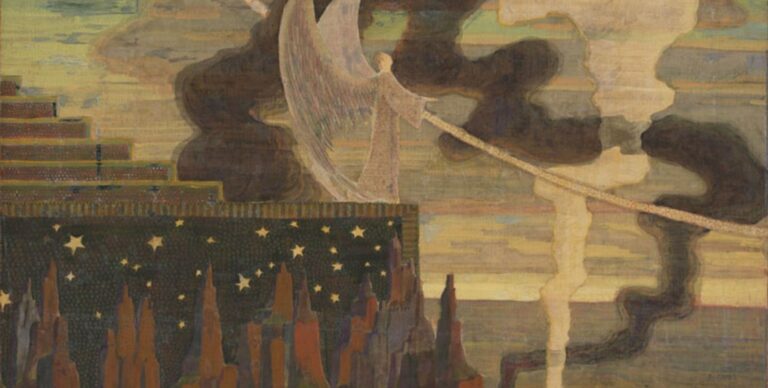In my endeavour not to spend my days in misery, last Monday I went to Fondazione Prada here in Milan to see their new temporary exhibition: Folding Screens from the 17th to the 21st Century. It’s the kind of thing I would have visited when I was more into design, and yet I enjoyed it for many reasons.
The Concept
That of fhe folding screen is thus a story of cultural migration, hybridisation, collaboration and what this object conceals and reveals, retains and unfolds. This story, and especially the way it manifests itself in the present, is a narrative of liminal objects and the very concept of liminality: being between one thing and another, literally and metaphorically, undermining the rigid distinctions and hierarchies between different disciplines, art and architecture, decoration and design.
I’ve always been partial to folding screens, no doubt under the influence of one of my first employers: Italian design and architect Piero Lissoni.
He used folding screens a lot, in his interior design, especially in public places. I mostly worked on the construction of hotels: designing and finding folding screens was always one of the most delicate and intellectually stimulating parts of the job, as odd as it might sound.
The Setting
The exhibition takes place on two levels in the so-called podium of the complex and it’s designed by SANAA, as you immediately guess by taking a look at the curved glass partitions and sinuous sets of curtains.
Regardless of how fed up you might be with this signature style, especially if you walk past the Bocconi campus every day, there’s one thing you have to admit: at the ground level of the podium, SAANA was able to create an intriguing itinerary in what would have otherwise been a banal and rectangular room. They create screens inside an exhibition on folding screens. How avant-guard.
Alas, the second level is far less interesting but then, you can’t see it from the street: you only see it if you’re actually interested in the exhibition and this is Fondazione Prada after all.
The exhibition has six sections on the ground floor:
- “Readings, East and West”, reflecting on how you read a folding screen depending on the culture and significance: from left to right, the other way around, front and back, top to bottom;
- “Public / Private”, highlighting how folding screens have traditionally been used to create intimate spaces and how this gives the object a sensual, sexual and erotic connotation;
- “Split Screens”, melts the physical world and the digital experiences;
- “Four Seasons: Space and Time, Figuration and Abstraction”, looks at the folding screen as a storytelling medium;
- “World of Interiors” looks at the folding screen in its primary function: a piece of furniture;
- “Parody / Paradox”, looks at transparent screens that do not seem to fit their purpose and often employ irony to highlight social paradoxes.
At level one, the exhibition takes a chronological approach instead of a theme-based one.
My top 10 in the exhibition
It would be madness to list all the pieces one by one. Still, there are so many that I can hardly command myself to resist the urge. It has been hard to shrink it down to just 10.
10. Goshka Macuga, In Time or Space or State (2023)
The screen is created by bookshelves and the symbolic division of a metal detector, of a security gate. Israel and Palestine, Russia and Ukraine, China and Taiwan are on opposite sides of the screen, in an expressive gesture that clearly wants to express a relatable concept and yet I can’t help but question it intellectually, as the division between Israel and Palestine are far from being the same as Russia and Ukraine.
Still, if the idea is to tear the bloody thing down, I couldn’t agree more.
9. Macao and Canton
Portuguese sources from the XVI century claim that, in 1543, a ship trading through the South Chinese Sea was thrown off course by a typhoon and ended up in the Japanese archipelago. Civil war was raging in the area, piracy had led the Chinese government to stop all sailing, and the Portuguese saw an opportunity to broker a deal between the struggling China and the rich Japanese merchants. This movement eventually led to the Portuguese settlement on the coast of Guandong, where they could make a port between Malacca and Japan. This port will be known as the city of Macao. This anonymous Chinese screen from the second half of the XVII Century is one of many showing Westerner ships in an oriental style.
Another wooden painted screen from the second half of the XVIII Century comes from the Oriental Art Museum in Lisbon and it’s absolutely delightful, much more to my taste than the two massive golden screens placed in front of it. It shows a view of Macao, meticulously depicting the Portuguese monuments, while on the other side we find Canton, with the Lui-rong pagoda, the Mohammedan minaret and the triumphal arc. The piece was probably commissioned to document the Portuguese influence in the region, but the particular choice of framing and composition makes this a vibrant piece on the reality of colonialism.
A third glorious Japanese screen from the XVIII Century, coming in through Portugal, depicts the very western ship that would probably bring back the piece during the period in which relationships between Japan and Portugal were more open.
8. Chen Zhifo, Seasonal Flowers and Birds (1947)
Another favourite of mine in the exhibition, this Seasonal Flowers and Birds is from 1947 and represents the classical theme of seasons, using a technique called gongbi that involves highly detailed brushstrokes and an abstract quality to the composition.
7. William Morris (panels: 1860, screen: 1889)
Designed on a project by William Morris but embroidered by Elizabeth Burden, sister-in-law of the artist, and by his wife Jane Morris. The subjects of the screen are three heroines: Lucretia (I wrote about her here), Hippolyta queen of the Amazons, and Helene of Troy. The three women embody three different sides: strength in the face of ordeals, active power and the more passive power, if you will, of beauty intertwined with fate.
6. Man Ray, Les Yeux Fertiles (1935)
Dedicated to Faili Elliard, the folding screen is inspired by one of his poem and depicts a young woman, posing as a Venus but deprived of her right to show a face. A plethora of red glowing eyes draws the line of a fictional hill on her right, going down into the sea, while on the left a group of hands rise from a fountain.
5. Lê Phổ, Paysage du Tonkin (1932-34)
Amidst the production of this Vietnamese painter, the screen on display is possibly the largest and certainly unique in its employment of lacquer.
It’s said the geometrical elements were inspired by Jean Dunand, a Swiss and French Art Deco painter who worked as a decorator in Paris and whom Lê Phổ saw at the Colonia Expo of Paris in 1931. Through Dunand, Seizo Sugawara is an indirect influence and this is why we have this perfect mixture of oriental, geometrical and decorative art.
4. William N. Copley, Konku (1982)
Also known as CPLY, William N. Copley was an American Surrealist painter, writer, publisher and entrepreneur, precursory to Pop Art. He produced many folding screens and this Konku (1982) is part of a series denouncing the stereotypical distinction between “good” women and “bad” women, ofter using the figure of the prostitute as a paramount example: a role required by men, and yet judged and denounced by those same men.
The back of the screen is a flat pattern, with the writing “men” and pointing fingers both signifying direction and accusation.
On the front, figures of women in their lingerie are placed half-in and half-out, like a decorative motive of classical times, and significantly without a head nor a face.
3. Lorna Simpson, Screen 4 (1986)
Her Screen 4 (1986) is part of a series denouncing the sexualization of black women. In the words of Bonita Mclaughlin as quoted by the curators:
“Simpson draws attention to the emphasis and sexuality that often accompanies representations of black women, simply by omitting it. Showing herself with her arms crossed, or resting on her hips, or stretched along her sides, and wearing a common, loose, crumpled white pinafore, Simpson’s model chooses not to please or attract. The gap between her reality and the desire for eroticism inherent in the male gaze is evoked in the quote on the left panel.”
The writing says: “She was no more exotic than the sparse room she posed in.”
2. Carrie Mae Weems, The Apple of Adam’s Eye (1993)
The Apple of Adam’s Eye (1993) is a painted and embroidered screen denouncing gender and role differences in the biblical story of Adam and Eve. The naked body of the woman is completely covered by a veil and it’s a mere allusion.
The front reads: “She’d always been the apple of Adam’s eye”.
The rebellious approach, however, is evident from the quote at the back of the folding screen, which reads:
Temptation my ass, desire has its
place, and besides, they were both
doomed from the star.
The quote is adorned with a falling leaf fashioned like the feather of a cursed angel.
1. Lisa Brice, Untitled (2022)
Another potent piece of the exhibition, untitled and made last year, it’s a folding screen painted with different pigments on a simple wooden support and it’s a fierce denounce of patriarchy. In a dark, suffocating interior, a group of different women are gathered and drink, smoke, talk, read, think: all covert activities to the patriarchal society. The clearest denounce is a paintress, in the foremost left panel, who’s painting a new version of Gustave Courbet‘s famous Origin of the World but is doing so in secret, covering herself with a drape and holding between her legs a mirror we cannot see: we are only allowed to see what she represents of herself, and this is one of the strongest assertions of freedom you will find.
Extra features
I couldn’t feature them among my favourites, but I couldn’t scratch them either. Here’s another bunch of interesting stuff, in sparse order.
Anthea Hamilton, Shame Paravent (2023)
Her work, also a very recent piece from this year, is a statement on the very concept of shame through the choices of materials, as it uses oak wood, chestnut husks, rattan, goat wool.
“To me, in the idea of the screen, there is an implicit subtext of shame; it is always – in scale and use – in relation to the body. Shame develops in itself and is visual; guilt depends on an external judge and is acoustic. Shame is a revolutionary feeling.”
Elmgreen & Dragset, Paravent (2008)
“My favourite sculpture is a wall with a hole framing the space on the other side.”
– Andy Warhol
Willing alluding to Warhol’s favourite sculpture being a glory hole, this is what the Danish and Norwegian couple propose to us: a scene dripping queerness with two pairs of Levi’s 501 jeans and some toilet paper.
Kenneth Halliwell, Cat Screen (1966)
This decoupaged folding screen with quaint figures of cats and (less quaint) figures of Egyptian tragedies is at the centre of a tragedy: it was done by Kenneth Halliwell in his house on Noel Road, in Islington, where he was living with playwright Joe Orton. The couple used to take books from libraries, paste pictures of naked men and cats between their pages and then give them back, so that other readers might find the “surprise”.
No, I do not approve.
Nor do I approve of the fact that Halliwell eventually killed Orton, in August 1967, before killing himself.
Here’s a close-up of the screen.
Hernan Bas, Decorative screen for the foyer of a homosexuals summer home (2012)
An astonishing piece, the reverse of Elmgreen & Dragset’s and a style much more akin to my taste: the homosexual aesthetics and identity aren’t explored through the pursuit of the crude.
Golden foil with fading sunflowers and a derelict home on a hill are much better than Levi’s jeans and toilet paper. But then again, I’m not a gay man.
Francis Bacon, Painted Screen (1929)
Francis Bacon worked as an interior decorator in Paris between 1928 and 1930, and I have a hard time picturing him in pursuit of chairs, tables and armoirs. Folding screens and carpets are an entirely different matter, and much more akin to painting. They’re decoration, though, and the artist came to loathe the word, so much that this piece stayed hidden in his study for many years.
Giacomo Balla, Screen with Interpenetrating Forms (1932)
Giacomo Balla, an icon of Italian futurism and a highly prolific painter produced many folding screens and they’re all in the same style: flat shapes, intertwining one to the other, and more akin to a fashion pattern than to the compositions of his paintings. This screen is no exception.



























No Comments